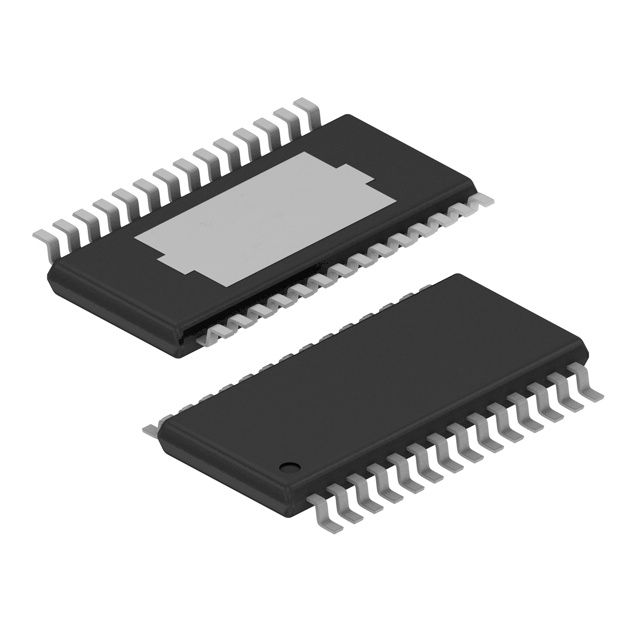Viz Specifikace pro podrobnosti o produktu.

TPS54680PWP
Product Overview
Category
The TPS54680PWP belongs to the category of integrated circuits (ICs) and specifically falls under the power management ICs.
Use
This IC is primarily used for voltage regulation in various electronic devices and systems. It provides efficient power conversion and management capabilities.
Characteristics
- High efficiency: The TPS54680PWP offers high efficiency power conversion, minimizing energy loss during voltage regulation.
- Wide input voltage range: It can handle a wide range of input voltages, making it suitable for diverse applications.
- Adjustable output voltage: The IC allows for adjustable output voltage, providing flexibility in different scenarios.
- Protection features: It incorporates various protection mechanisms such as overvoltage protection, overcurrent protection, and thermal shutdown.
Package and Quantity
The TPS54680PWP comes in a small outline package (SOP) with a PowerPAD™ thermally enhanced package. It is available in reel packaging, with a quantity of 2500 units per reel.
Specifications
- Input voltage range: 4.5V to 17V
- Output voltage range: 0.6V to 5.5V
- Maximum output current: 6A
- Switching frequency: 300kHz to 2.5MHz
- Operating temperature range: -40°C to 125°C
Pin Configuration
The TPS54680PWP has the following pin configuration:
- VIN: Input voltage pin
- PGND: Power ground pin
- BOOT: Bootstrap capacitor connection pin
- PHASE: Phase node connection pin
- SW: Switching node connection pin
- SS/TR: Soft-start/Tracking pin
- FB: Feedback voltage pin
- EN: Enable pin
- VSENSE: Current sense pin
- VOUT: Output voltage pin
Functional Features
- High-efficiency synchronous buck converter
- Adjustable output voltage through external resistor divider network
- Soft-start and tracking functionality for controlled startup
- Overvoltage protection (OVP)
- Overcurrent protection (OCP)
- Thermal shutdown protection
Advantages and Disadvantages
Advantages
- High efficiency leads to reduced power consumption and heat generation.
- Wide input voltage range allows for compatibility with various power sources.
- Adjustable output voltage provides flexibility in different applications.
- Protection features ensure the safety and reliability of the system.
Disadvantages
- Limited maximum output current may restrict usage in high-power applications.
- Higher switching frequency may introduce electromagnetic interference (EMI) concerns in sensitive environments.
Working Principles
The TPS54680PWP operates as a synchronous buck converter, converting a higher input voltage to a lower output voltage efficiently. It utilizes pulse-width modulation (PWM) techniques to regulate the output voltage based on feedback from the FB pin. The integrated control circuitry adjusts the duty cycle of the switching transistor to maintain the desired output voltage.
Application Field Plans
The TPS54680PWP finds application in various fields, including: 1. Consumer electronics: Power management in smartphones, tablets, and portable devices. 2. Industrial equipment: Voltage regulation in industrial automation systems and machinery. 3. Automotive electronics: Power supply for automotive infotainment systems and advanced driver-assistance systems (ADAS). 4. Telecommunications: Power management in networking equipment and communication devices. 5. Renewable energy systems: Voltage regulation in solar power inverters and wind turbine controllers.
Alternative Models
For those seeking alternatives to the TPS54680PWP, the following models provide similar functionalities: 1. LM2596S-ADJ 2. LT8610AB 3. MP2307DN 4. TPS54360DDAR 5. MAX15062
These alternative models offer comparable features and can be considered based on specific requirements and availability.
In conclusion, the TPS54680PWP is a versatile power management IC that offers high efficiency, adjustable output voltage, and various protection features. Its wide range of applications and availability of alternative models make it a popular choice in the field of voltage regulation and power management.
[Word count: 529]
Seznam 10 běžných otázek a odpovědí souvisejících s aplikací TPS54680PWP v technických řešeních
Sure! Here are 10 common questions and answers related to the application of TPS54680PWP in technical solutions:
Q: What is the TPS54680PWP? A: The TPS54680PWP is a synchronous buck converter integrated circuit (IC) designed for high-efficiency power supply applications.
Q: What is the input voltage range of the TPS54680PWP? A: The TPS54680PWP has an input voltage range of 4.5V to 17V.
Q: What is the output voltage range of the TPS54680PWP? A: The TPS54680PWP can provide an adjustable output voltage range from 0.6V to 6V.
Q: What is the maximum output current of the TPS54680PWP? A: The TPS54680PWP can deliver a maximum output current of 6A.
Q: What is the efficiency of the TPS54680PWP? A: The TPS54680PWP offers high efficiency, typically up to 95%.
Q: Does the TPS54680PWP have built-in protection features? A: Yes, the TPS54680PWP includes various protection features such as overcurrent protection, thermal shutdown, and undervoltage lockout.
Q: Can the TPS54680PWP be used in automotive applications? A: Yes, the TPS54680PWP is suitable for automotive applications due to its wide input voltage range and robust protection features.
Q: What type of package does the TPS54680PWP come in? A: The TPS54680PWP is available in a small 20-pin HTSSOP package.
Q: Is the TPS54680PWP easy to use in a design? A: Yes, the TPS54680PWP is designed for ease of use with features like adjustable soft start, voltage tracking, and pre-bias startup.
Q: What are some typical applications for the TPS54680PWP? A: The TPS54680PWP can be used in various applications such as point-of-load converters, telecom equipment, industrial automation, and consumer electronics.
Please note that these answers are general and may vary depending on specific design requirements and application scenarios.

